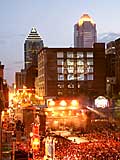5.5
Increase the Centre’s cultural outreach
The Centre is home to nearly 80% of Montréal’s cultural activity. The abundance and variety of its cultural facilities make it the primary launch point for the development and dissemination of Québec culture and a point of contact with many foreign productions. It sets the stage for the development of Québec’s cultural potential.
Above and beyond their considerable economic contribution and the tourism they generate, Montréal’s cultural institutions, particularly its museums, play a fundamental educational role that contributes to the development of a sense of civic pride. Reminders of the past and places of culture, museums enable Montrealers of all backgrounds to encounter other cultures.
The Ville de Montréal acknowledges their role and advocates the creation of large cultural facilities along with the consolidation of existing ones in the Centre. This reflects its commitment to making major cultural events accessible to the public. Superior public transportation services and high visitor volume make the Centre the ideal location for events of a metropolitan or international stature.
 A number of concert halls, theatres, studios, art galleries and exhibition spaces are located in the vicinity of Place des Arts, along Bleury, Sainte-Catherine, Saint-Denis and Saint-Laurent. The area harbouring this concentration of cultural activity is known as the Quartier des Spectacles.
A number of concert halls, theatres, studios, art galleries and exhibition spaces are located in the vicinity of Place des Arts, along Bleury, Sainte-Catherine, Saint-Denis and Saint-Laurent. The area harbouring this concentration of cultural activity is known as the Quartier des Spectacles.
Despite the popularity of the events that are held periodically in the Quartier des spectacles, its image or recognition does not correspond to its vocation. As one of the key sites targeted by the Master Plan for increasing the Centre’s cultural outreach it will be subject to a detailed planning process in order to increase its cohesiveness and appeal (see Section 4.22).
Artists and Artisans
The cultural life of the Centre is generated in part by the presence of numerous artists and artisans that create, produce and exhibit a wide range of works. City by-laws currently allow the creation of workshops in most areas where the dominant land use is commercial or industrial. In the framework of its Cultural Development Policy, the City will implement tools and a plan of action to consolidate and develop artists’ studios and live-work spaces.
Implementation measures
- Consolidate the built environment and retail activity
along Sainte-Catherine in Faubourg Saint-Laurent.
- Improve the design of the main links between the
Quartier des spectacles and adjacent areas.
- Convert some vacant lots into new public spaces.
- Facilitate proximity of cultural creation, production
and exhibition facilities.
- Pursue and intensify the integration of works of art
into the public realm, particularly when designing new public spaces and
promote this practice on private property.
- Heighten the visibility of cultural facilities (e.g.:
with special signage or distinctive public space design).
- Implement the Politique culturelle de Montréal (City’s Cultural Policy).